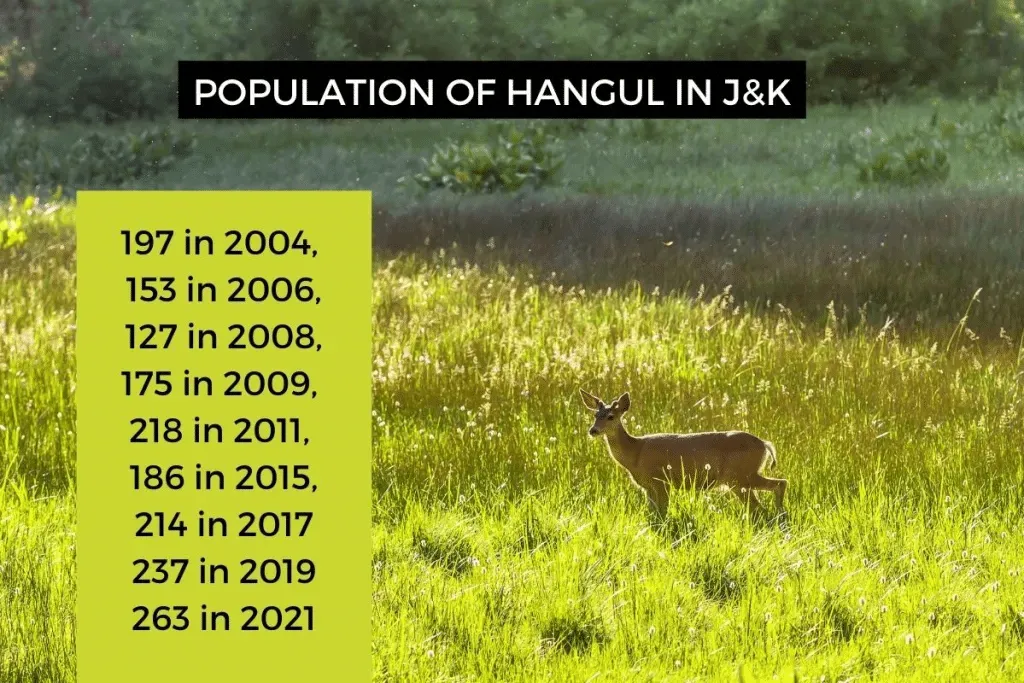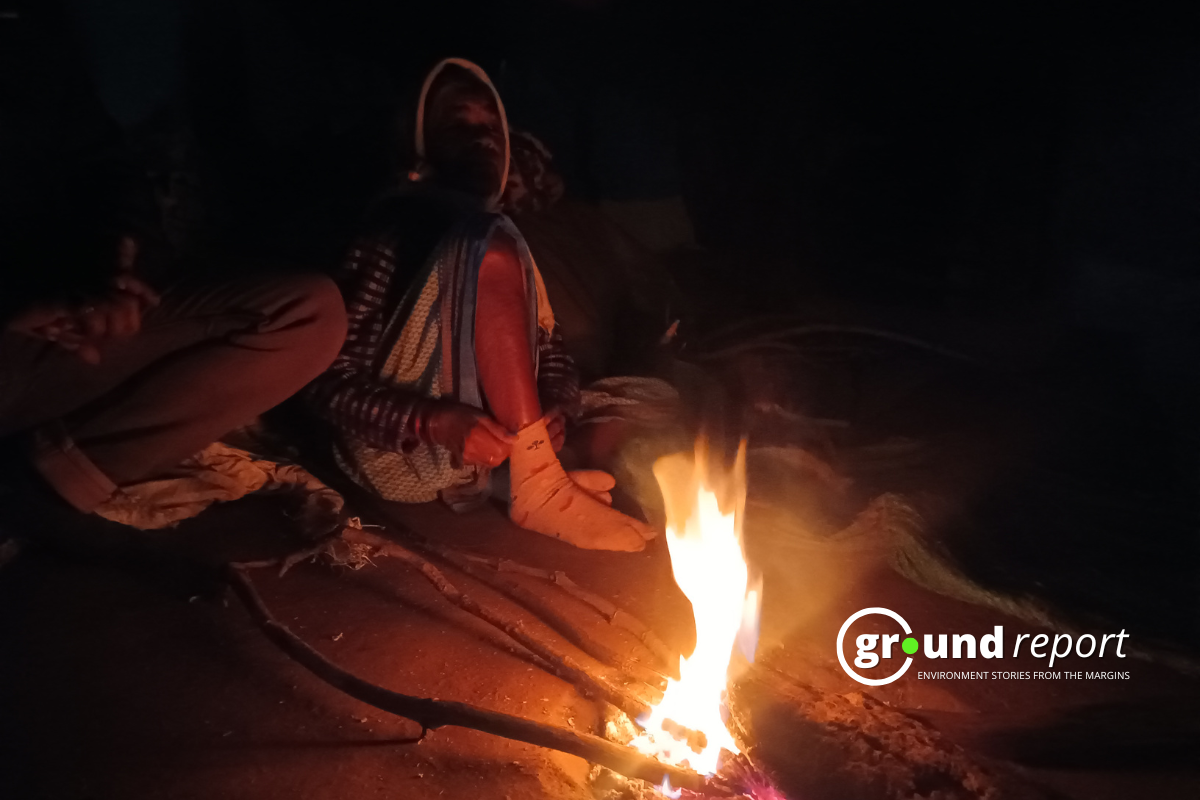The number of Kashmir stag, known as hangul has declined since the early 20th century. In the early 1900s, the Kashmiri hangul deer population was estimated to be around 5000. Numbers have dwindled to only 261, with perhaps fewer reportedly surviving today.
Kashmiri Hangul population
The census revealed that the number of Hangul males per 100 females was 126 in 2021 down from 153 in 2019. The number of fawns per 100 females has increased to 13.4 in 2021 from 9 in 2019.
He said the census reports available with the department show the annual hangul counting started in 2004 using scientific methods which estimate the population at 197 in 2004, 153 in 2006, 127 in 2008, 175 in 2009, 218 in 2011, 186 in 2015, 214 in 2017 and 237 in 2019.
While there have been varying estimates of the Hangul population over the years, with differences in data between official population statistics and independent research, the population is certain to be somewhere between 100 and 261. This is a significant decline since the early 20th century when the hangul population was estimated to be around 5,000. Those who study and monitor deer are now concerned that this critically endangered species (Hangul) could soon face extinction.
Some wildlife experts and activists have attributed the decline to the construction of cement factories near the animal’s habitats and wildlife sanctuaries. In addition, the construction of defense infrastructure and other human interventions have led to the fragmentation of their habitat, they point out.
Some wildlife experts and activists have attributed the decline to the construction of cement factories near the animal’s habitat and wildlife sanctuaries. In addition, the construction of defense infrastructure and other human interventions have led to the fragmentation of their habitat, they point out.
Hangul is not easy to spot. They are shy and quickly disappear into oak groves when they sense a human nearby.
Government measures
Acknowledging that this was a situation that required urgent attention, Jammu and Kashmir Minister of Forests, Environment and Ecology Bali Bhagat said that his ministry had realized this reality and was restarting the necessary measures to conserve the animal. state.
The Hangul Project aimed to use modern technology to survey the hangul habitat and begin ex situ breeding to increase the Kashmiri deer population. A breeding center was spread over a five-acre wooded area in southern Kashmir and the idea was to release fawns into the wild with radio collars to track their movements.
Listed under schedule I of the Jammu and Kashmir Wildlife Protection Act 1978 and the Indian Wildlife (Protection) Act 1972, the hangul is among the four subspecies of red deer more widely distributed in the east, but at present, the Hangul population is restricted to Dachigam National Park.
Bacha said that last year he took a census of the Hangul population, inside and outside the Dachigam National Park, and his findings revealed that there are 110-130 Hanguls inside, while 40-50 deer outside the park on the mountain range. from the Himalayas.
Department officials claimed they too conducted the Hangul census, but quickly added that “the report is being analyzed and will be released soon” without providing clear details.
According to Bacha, in the 1940s, the population was between 3,000 and 5,000, but this number dropped to 160 in the 2008 census.
The IUCN Red List has designated it Critically Endangered, and it is also listed by the Convention on International Trade in Endangered Species of Wild Fauna and Flora (CITES)
Rise of cement factories
In the mid-1980s, the then government of Jammu and Kashmir established a cement factory in the Khrew area due to the huge limestone deposits in the adjacent mountain range.
According to some estimates, there are currently about six cement factories in operation in Khrew, a fairly small town stretching over 12 km2.
A local activist campaigning against the cement factories, Adil Bhat, as well as some other activists, have said that since the government-owned factory was established, at least seven other privately owned cement factories have been established in the area some point out, it is likely a violation of wildlife conservation rules.
“Hangul is sensitive to smell and sound at a long distance. The sound is a big disturbance for hangul,” Ahmad said, referring to the explosion of limestone deposits around Khrew. He has done extensive studies on the ecology and biology of Hangul. In his experience, he notes that factory emissions have likely affected Hangul’s physiology and eating patterns. “Chemical emissions (particles) from cement factories rest on the grass in inhabited areas that Hangul consumes,” he said.
Increase in population
Altaf Hussain Dentoo, Wildlife Warden, Central Division speaking to Groundreport.in that there is a gradual increase in the population and there are no worrying factors.

“As the hangul is endangered, but like other animals, they get their food naturally. In winter, during snowfall, we throw some vegetables, fresh leaves and other things at them,” he said.
Teams are being sent to the ground to find the Hangul population and this time we are using genetic methods to find the Hangul population, he said.
“The hangul fecal matter will be sent to the Hyderabad laboratory where, through a highly advanced method, we will find out the total number of hangul,” Altaf said.
Keep Reading
Part 1: Cloudburst in Ganderbal’s Padabal village & unfulfilled promises
India braces for intense 2024 monsoon amid recent deadly weather trends
Support us to keep independent environmental journalism alive in India.
Follow Ground Report on X, Instagram and Facebook for environmental and underreported stories from the margins. Give us feedback on our email id greport2018@gmail.com.
Don’t forget to Subscribe to our weekly newsletter, Join our community on WhatsApp, and Follow our YouTube Channel for video stories.









